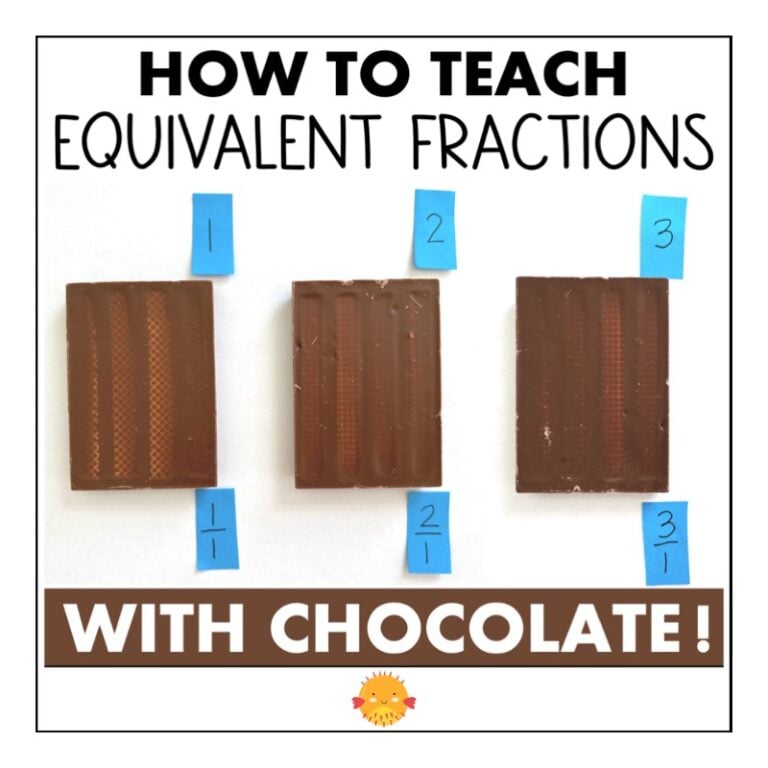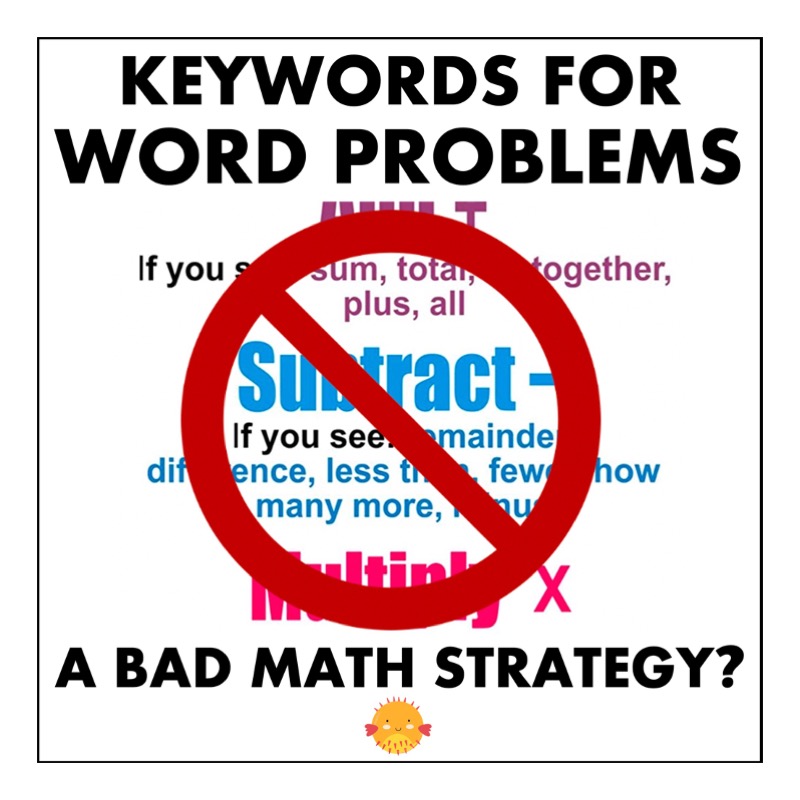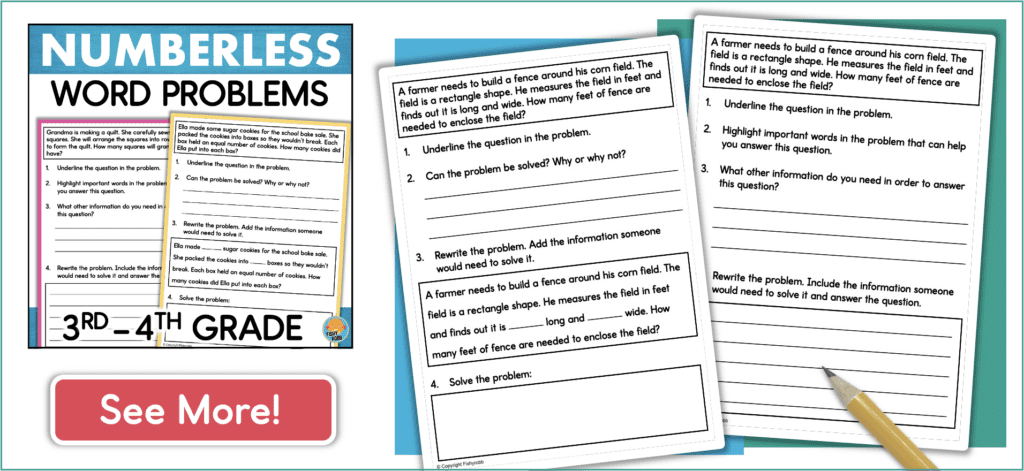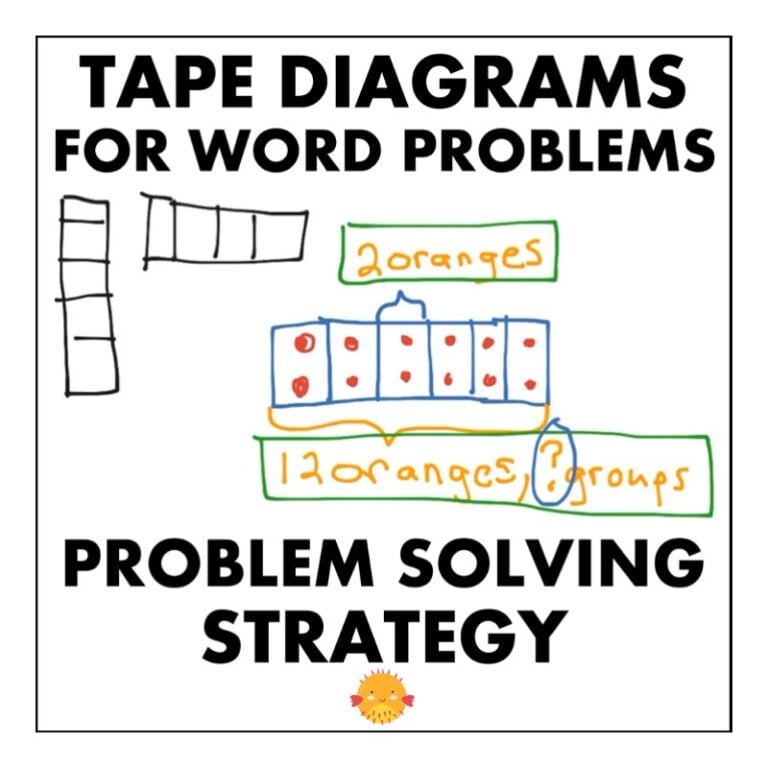
Stop Teaching Keywords for Math Word Problems! 5 Better Ways to Solve
Back in college I took a course called Teaching Math In Elementary School. One of our assignments was to create an anchor chart of different strategies for teaching word problems. I don’t recall what my group came up with, but at least half of the class made handy reference posters showing keywords for math word problems. Apparently this was A-okay with our professor because they were hung all around the room.
You know the kind of posters I’m talking about. Ones like this with specific words students should look for and circle in their story problems…

Teachers still have anchor charts like this and still teach kids to use clue words for all types of problems in math. I’m here to tell you to stop, or at least be very careful when teaching this as a problem solving strategy.
Why? There are far more effective ways to problem solve and arrive at the correct than using keywords for math word problems.
.
Why you shouldn’t teach keywords for math word problems
.
Critical thinking is a very important skill in math. Don’t you agree?
When you teach kids to look for word problem keywords, you’re teaching them to NOT think through the problem completely. Using keywords is way a to opt-out of analyzing the problem from beginning to end. In the long run, this creates weaker math students.
Children who have been taught the keyword strategy usually don’t study a problem. They don’t think about the problem’s meaning or what is happening or how they could figure it out in the real world.
Instead of developing a variety of strategies, a lot of students just scan through the problem, searching for those all-important common words, until they strike gold. Then they use whatever mathematical operations “go with” that keyword… even if it doesn’t make sense.
Not sure about this? Let’s try using some keywords for math word problems and see how it works out…
Examples of Keywords for Math Word Problems That Don’t Work
.
“In All” means you should add.
One of the most common keywords teachers like to use is “in all”. I’ve seen it used at almost every grade level with addition word problems.
Let’s look at some examples:
- Mary had 12 green apples. She bought 7 more. How many did she have in all? Easy! 12+7=19 green apples. Maybe it does work…
- How about this one… John bought 7 cartons of eggs. Each carton contains 12 eggs. How many eggs did he buy in all? Umm, 7+12=19 eggs?
- 75 people visited the museum on Sunday. Twice as many visited on Saturday. How many people visited the museum in all? Oh no, what do I add? There’s only one number!
.
As you can see, students need to understand the problem’s meaning before they can figure out what type of math operation to use.
.
“How many more?” means you should subtract.
Surely keywords will work for subtraction word problems, right? Let’s give it a go…
- The third grade is going on a field trip. 44 students fill up the first bus. How many more buses are needed for the other 70 students? Hmm… 70 – 44 = 26 buses. That seems like an awful lot of buses!
- Sam went to a movie that started at 2:45 and ends at 4:10. It is now 3:30. How many more minutes are left before the movie is over? Uhhhhh….
.
These are just a few examples of why keywords often don’t work for solving different types of word problems.
It gets even messier when students are asked to explain their thinking or to draw a model, as they so often are on today’s math assessments. Not only do they get the wrong answer, but the only explanation they can come up with is, “Because the problem said ‘in all’ and that means you add.”
And what about two-step word problems? Those often involve different operations and different key words. Or how about using inverse operations to solve? That’s a totally valid way to approach a math problem, but key words don’t help with that.
You see, there isn’t just one right way in math or one correct operation. Now, this is not to say key words can’t be helpful at times. You can give students a little cheat sheet to keep in their math folder. But teach other strategies first.
.
How to Solve Word Problems Without Using Keywords
Instead of using keywords for math word problems, teach your students these strategies that will also help them build critical thinking skills:
.
Have students verbalize the problem
Ask them to rephrase the problem in their own words and verbally describe what is happening. I do this almost daily during my guided math groups. This shows me that they understand what the problem is saying.
.
Teach Students to identify different types of problems
This is one of my favorite strategies. Ask – Does the problem involving getting more of something, comparing quantities, an unknown number? These are all very important pieces of information that will lead students to the solution.
.
Start with Numberless Word Problems
Pose a situational problem to your class without specific quantities. Discuss it as a group. Have students explain or even act out the problem.
For example, when introducing division to my students, I might say – Tom has a pile of wood planks. He wants to use all of the planks to build coops for his chickens. Each coop will be the same size. How can he figure out how many planks to use for each coop? What information does he need to know?
Without providing actual numbers, students can freely think about what Tom needs to do to turn his pile of wood planks into coops. They will talk about how Tom can make equal piles of planks, one for each coop, and see if any are left over. As they do this, the students are beginning to understand what division is without even doing any math.

.
Teach Students to Write Their Own Word Problems
This involves higher level thinking and a strong ability to draw connections between words and numbers. If a student can put together all of the necessary components of a word problem, they have the ability to solve one.
.
Use graphic organizers and visual models
My favorite graphic organizer for math is the bar model or tape diagram. It’s a great way for students to visualize mathematical problems and understand the relationship between the numbers. Many times students will independently realize their math mistakes when they plug the numbers into a tape diagram and realize it just doesn’t work.

.
I hope this blog post has given you some new ideas to teach word problems with your students. I think you’ll find that once your students have other strategies, their critical thinking skills will improve and they won’t need to rely on keywords for math word problems.
Still not convinced? Check out this information brief from NC2ML: The Limitations of Keyword Strategies



